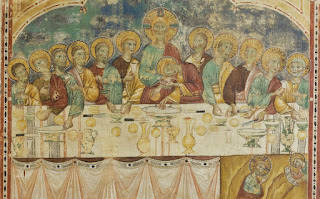MEDIEVAL ART
MEDIEVAL PAINTING
Art during the Middle Ages saw many changes up to the emergence of the early Renaissance period. Early art subjects were initially restricted to the production of Pietistic painting (religious art or Christian art) in the form of illuminated manuscripts, mosaics and fresco paintings in churches. There were no portrait paintings in the art of the Middle Ages. The colors were generally somewhat muted. The subject of Medieval architecture is also covered in this section.
The medieval period of art history spans from the fall of the Roman Empire in 300 AD to the beginning of the Renaissance in 1400 AD. In the Middle Ages, art evolves as humans continue addressing the traditional and the new, including Biblical subjects, Christian dogma, and Classical mythology. This article introduces a few concepts of three periods—Early Christian, Romanesque, and Gothic.
Last Supper
At the beginning of the eleventh century, Romanesque architecture symbolized the growing wealth of European cities and the power of Church monasteries. For example, Romanesque buildings, especially monasteries and churches, were marked by semi-circular arches, thick stone walls, and stable construction. In 1070 or 1077 AD, St. Sernin, located in Toulouse, France, was built with a stone barrel vault ceiling. St. Sernin is remembered as a model of the Romanesque “pilgrimage church.”
The Gothic style developed in the middle of the twelfth century and is named after the Goths who ruled France. Some contemporaries of the Goths thought the use of figures such as gargoyles was hideous, but Gothic cathedrals represent the most beautiful and timeless accomplishments of the period. For example, Notre Dame Cathedral in Paris has been added to many times since the twelfth century, but it still bears important Gothic features such as gargoyles and flying buttresses.
There are plenty of ways to analyze 900 years of medieval art, including examining decorations inside churches. Human forms such as the Madonna and Baby Jesus evolve from large heads on small bodies in Early Christianity to abstract forms in the Romanesque era. In the Gothic era, the Madonna and Child are more naturalistic with tall, bony figures. Even the facial features of the Madonna and Child changed over 900 years. By the Gothic era in France, Mary had an approachable, warm countenance, signaling the Church’s recognition that images should attract people instead of intimidating them. In the Renaissance, artists would become bolder about exploring the themes of Christianity even in works commissioned by the Church.




Comments
Post a Comment